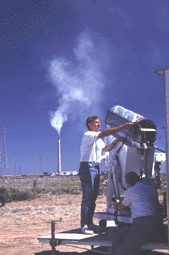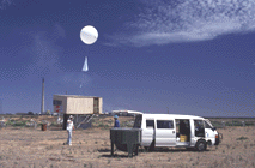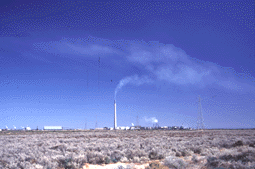Why do this Study now?
The instruments and technology used in this study only became available
in late 1995. We were the first private company to gather all the technology
together and commission such an intensive study.
The CSIRO Atmospheric Laser (below)
used to track and measure stack plumes

How was the study carried out?
A Group of 16 Scientists and technicians spent 24 days conducting a field
study in and around Port Pirie. They used time-lapse video, a mobile SO2
Analyser, an Atmospheric Laser and a specially fitted air craft to track
plumes from the various stacks within Pasminco. The stack plumes were injected
with fly ash to ensure that were visible during the study period.
To precisely record the meteorology, they used 3 weather stations, weather
balloons and monitors within the air craft. All these instruments gave an
overall picture of the exact timing and weather conditions that prevailed
when there was an increased level of SO2 in the town, and from which stack
the SO2 was emitting.
What did the study reveal?
The study was an outstanding success. We now know what weather conditions
relate to elevated incidents of SO2 in the town. We also learnt some very
interesting facts about our unique weather pattern here in Port Pirie. Located
on a headland, we have extremely complex weather conditions. For example,
a sea breeze behaves quite differently depending on whether it is blowing
from the Port Davis area or the Port Augusta area. It is also not unusual
to have a situation where winds are blowing in different directions on opposite
sides of the town. Hot calm (convective) days during summer, increase the
complexity of these conditions.
The study also confirmed that for 98.5% of the time the Tall Stack works
effectively. The 1.5% of times when the Tall Stack does not work effectively
are the times when a sulphurous odour may be smelt throughout the town. This
occurs when there is convective weather conditions. Additionally, it was
found that other stacks did not exceed the current air quality goals.
 |
 |
Launching weather balloons on the eastern side of Port Pirie |
Fly ash stack plumes illustrate how the
complex weather conditions in Port Pirie
can result in the wind blowing in two
opposing directions at the same time |
Identifying which stack we need to focus on and understanding Port Pirie's
unique weather conditions is the first step towards ensuring the long term
improvement of air quality in Port Pirie.
Where do we go from here?
A number of preliminary process and engineering options to reduce SO2 are
being examined by an experienced project team at Pasminco Port Pirie. The
ultimate aim for this team is to find a feasible way of significantly diminishing
the amount of SO2 that goes up the Tall Stack. The team will need to ensure
that the final solution is sustainable in terms of the environment as well
as meeting the operational and marketing objectives of Pasminco.
This project illustrates the ongoing commitment of Pasminco to the community
of Port Pirie. We continuously examine all our processes from both a company
as well as a community perspective. Although this project is only in the
initial stages we are dedicated to finding the best possible solution for
all parties. If anyone has any further questions regarding the Study please contact
Ms Susan Rana, Senior Public Affiars Officer, Pasminco - Port Pirie, (086)
38 1206
[top]
Modified:
9/10/08
|



